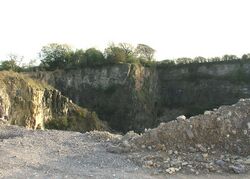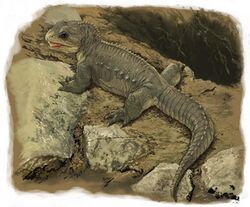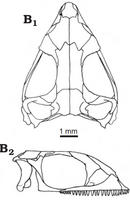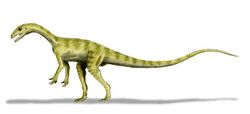Earth:Pant-y-Ffynnon Quarry
| Pant-y-Ffynnon Quarry fissure fills Stratigraphic range: Rhaetian, ~215–201 Ma | |
|---|---|
 Pant-y-Ffynnon Quarry | |
| Type | Fissure fill |
| Overlies | Friars Point Limestone Formation |
| Lithology | |
| Primary | Breccia |
| Location | |
| Coordinates | [ ⚑ ] : 51°27′29″N 3°22′26″W / 51.458°N 3.374°W |
| Region | South Wales |
| Country | Wales |
| Lua error in Module:Location_map/multi at line 27: Unable to find the specified location map definition: "Module:Location map/data/Wales" does not exist. | |
Pant-y-Ffynnon Quarry is a stone quarry in the Vale of Glamorgan, Wales, around 3 kilometers east of Cowbridge.[1] It contains fissure fill deposits dating to the Late Triassic (Rhaetian), hosted within karsts of Carboniferous aged limestone, primarily the Friars Point Limestone Formation. Remains of numerous small vertebrates, notably archosaurs, are known from the fissure fills in the quarry, similar to other Late Triassic-Early Jurassic fissure fill deposits known from Southwest England and southern Wales.
History
The quarry was likely in use since at least the 1910s, and the first fossil specimens discovered at the quarry were collected by palaeontologists Kenneth Kermack and Pamela Robinson of University College London between 1951 and 1952, and were first presented at a talk in 1953 and later written on briefly in 1956.[2] The quarry was abandoned during the 1960s and few fossil discoveries have been made there since. Much of the remains discovered between 1951-52 were left undescribed until the 21st century, with most only initially being briefly described upon discovery.
Vertebrate paleofauna
| Taxon | Species | Presence | Notes | Images |
|---|---|---|---|---|
| Aenigmaspina[3] | A. pantyffynnonensis[3] | Geographically present in Pantyffynnon[4] | Remains include osteoderms, vertebrae, ribs and a scapula clustered tightly together, as well as more pieces from the forelimb and additional vertebrae that likely belong to this individual.[3] Nicknamed 'Edgar'.[2] | |
| Clevosaurus[5] | C. cambrica,[5] C. sp.[5] | Geographically present in Pantyffynnon[4] | Partial cranial and post-cranial remains from several specimens, with bite marks belonging to Terrestrisuchus present.[5] | 
|
| Crinoidea[5] | Indeterminate[5] | Geographically present in Pantyffynnon[4] | Reworked from older Carboniferous sediments.[5] | |
| Crocodylomorpha[6] | Indeterminate[6] | Geographically present in Pantyffynnon[4] | Isolated bones associated with the holotype of Pendraig.[7] Likely the same animal as Terrestrisuchus | |
| Diphydontosaurus[5] | D. sp.[5] | Geographically present in Pantyffynnon[4] | Left dentary.[5] | 
|
| Kuehneosaurus[8] | K. sp.[8] | Geographically present in Pantyffynnon[4] | Indeterminate remains,[9] with Keeble et al. (2018) unable to source this specimen.[5] | 
|
| Lepidosauria | Indeterminate | Geographically present in Pantyffynnon[4] | Indeterminate remains. | |
| Pantydraco[10] | P. caducus[10] | Geographically present in Pantyffynnon[4] | Remains include a skull, a partial jawbone, and vertebrae of the cervix, an incomplete right pelvic bone, and partial forelimbs. | 
|
| Pendraig[7] | P. milnerae[7] | Geographically present in Pantyffynnon[4] | Remains include a partial pelvis, vertebrae and a left femur that is from the same individual was found disarticulated from the main block.[7] | 
|
| Rhynchocephalia[5] | Indeterminate[5] | Geographically present in Pantyffynnon[4] | Represented by one or two indeterminate species.[5] | |
| Terrestrisuchus[8] | T. gracilis,[8] T. sp.? | Geographically present in Pantyffynnon[4] | Several well-preserved articulated partial skeletons and various isolated bones.[8] | 
|
References
- ↑ Template:Coflein
- ↑ 2.0 2.1 Kermack, K. A. (1956). "An ancestral crocodile from South Wales". Proceedings of the Linnean Society of London 166: 1–2. doi:10.1111/j.1095-8312.1956.tb00747.x. https://academic.oup.com/proceedingslinnean/article-pdf/166/1-2/1/6589522/j.1095-8312.1956.tb00747.x.pdf.
- ↑ 3.0 3.1 3.2 Patrick, Erin L.; Whiteside, David I.; Benton, Michael J. (2019). "A new crurotarsan archosaur from the Late Triassic of South Wales". Journal of Vertebrate Paleontology 39 (3): e1645147. doi:10.1080/02724634.2019.1645147. https://cpb-eu-w2.wpmucdn.com/blogs.bristol.ac.uk/dist/6/525/files/2019/08/2019Edgar.pdf.
- ↑ 4.00 4.01 4.02 4.03 4.04 4.05 4.06 4.07 4.08 4.09 4.10 The dinosauria. David B. Weishampel, Peter Dodson, Halszka Osmólska (2nd ed.). Berkeley, Calif.: University of California Press. 2004. ISBN 978-0-520-94143-4. OCLC 801843269. https://www.worldcat.org/oclc/801843269.
- ↑ 5.00 5.01 5.02 5.03 5.04 5.05 5.06 5.07 5.08 5.09 5.10 5.11 5.12 5.13 Keeble, Emily; Whitestide, David I.; Benton, Michael J. (2018). "The terrestrial fauna of the Late Triassic Pant-y-ffynnon Quarry fissures, South Wales, UK and a new species of Clevosaurus (Lepidosauria: Rhynchocephalia)". Proceedings of the Geologists' Association 129 (2): 99–119. doi:10.1016/j.pgeola.2017.11.001. https://research-information.bristol.ac.uk/files/149334438/PantyF_MS_revised.pdf.
- ↑ 6.0 6.1 Warrener, D. (1983) "An Archisaurian Fauna from a Welsh Locality". (Unpublished PhD thesis in Zoology, University of London, London: 384 p).
- ↑ 7.0 7.1 7.2 7.3 Spiekman, Stephan N. F.; Ezcurra, Martín D.; Butler, Richard J.; Fraser, Nicholas C.; Maidment, Susannah C. R. (2021). "Pendraig milnerae , a new small-sized coelophysoid theropod from the Late Triassic of Wales" (in en). Royal Society Open Science 8 (10): 210915. doi:10.1098/rsos.210915. ISSN 2054-5703. PMID 34754500.
- ↑ 8.0 8.1 8.2 8.3 8.4 Crush, P. J. (1984). "A late upper Triassic sphenosuchid crocodilian from Wales". Palaeontology 27 (1): 131–157. https://www.palass.org/sites/default/files/media/publications/palaeontology/volume_27/vol27_part1_pp131-157.pdf.
- ↑ Fraser, N. C. (1986). Terrestrial vertebrates at the Triassic-Jurassic boundary in south West Britain, Modern Geology 10, 147–157
- ↑ 10.0 10.1 Yates, Adam M. (2003). "A new species of the primitive dinosaur Thecodontosaurus (Saurischia: Sauropodomorpha) and its implications for the systematics of early dinosaurs" (in en). Journal of Systematic Palaeontology 1 (1): 1–42. doi:10.1017/S1477201903001007. ISSN 1477-2019. http://www.tandfonline.com/doi/abs/10.1017/S1477201903001007.

